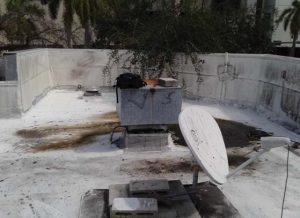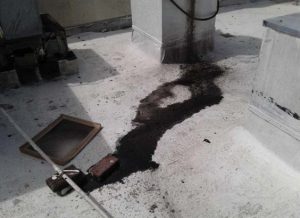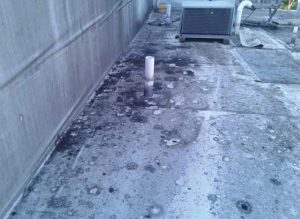— By Marian Nolletti —
The dangers of rooftop grease.
Any type of grease from animal fats or vegetable fats on a rooftop can reduce the roof system’s resistance to UV rays and heat. Plus, it can cause premature deterioration of your roof, as well as increase the risk of fires and slips and falls. If all of that isn’t bad enough, it can also void most roof warranties and violate environmental regulations.

Marian Nolletti, Simon Roofing
Grease will destroy any roof system if left sitting on it. Common defects from it include blisters, swelling and softening of the membrane, which causes it to become more like a sponge — not exactly a characteristic commonly desired in a roof! Affected adhesives or tapes can also lose their ability to stick, so seams open and roof leaks result.
All roofs naturally deteriorate because of oxidation, where natural elements like UV rays and water break down the polymers. In the case of grease, however, it creates acidic oxidation that significantly accelerates deterioration. Grease concentrates itself over time as more grease releases onto the roof. This allows for even more acidic oxidation to occur and will eat through the roof membrane. Roofs that are only a few years old sometimes must be replaced due to damage from grease.
Why Spilled Grease May Be Something to Cry Over
Spilled grease on a roof is a major safety concern as it greatly increases the risk for slips and falls for employees and vendors. Anyone accessing the roof should avoid the areas where grease may have spilled and stay on designated walk pads. Another safety concern is fire. Grease is a natural accelerant, which means it will spread a fire very quickly.
 When it comes to environmental regulations, improper disposal of grease is in violation of the federal Clean Water Act, as well as possibly other federal, state or local standards — especially in coastal areas of the country. Most require grease to be scraped up and disposed of in an appropriate container. Any sort of power washing requires a permit, and all water used must be collected and disposed of properly — usually at a wastewater treatment facility for a small fee.
When it comes to environmental regulations, improper disposal of grease is in violation of the federal Clean Water Act, as well as possibly other federal, state or local standards — especially in coastal areas of the country. Most require grease to be scraped up and disposed of in an appropriate container. Any sort of power washing requires a permit, and all water used must be collected and disposed of properly — usually at a wastewater treatment facility for a small fee.
Without proper containment, grease can run down gutters or off the side of a building and find its way into a storm sewer. Once in a storm sewer, that grease can end up in a nearby body of water where it can have a detrimental effect on the water, plant life and fish.
Grease is Unable to Contain Itself
Most roofing system warranties are voided by damage caused by grease. Without there being a roofing system that’s 100% impenetrable to grease, the most common solution is grease containment.
 Using containment is the safest way to manage grease, particularly if there are filters or absorbent material that prevent it from overflow. Enclosed containment systems can prevent rain from washing grease all over the roof. Regardless of the type, however, grease containment systems cannot be installed and ignored. They should be inspected on an ongoing basis and grease traps should be emptied regularly. For those systems with grease filters, the filters should be replaced as instructed but not less than every 6 months.
Using containment is the safest way to manage grease, particularly if there are filters or absorbent material that prevent it from overflow. Enclosed containment systems can prevent rain from washing grease all over the roof. Regardless of the type, however, grease containment systems cannot be installed and ignored. They should be inspected on an ongoing basis and grease traps should be emptied regularly. For those systems with grease filters, the filters should be replaced as instructed but not less than every 6 months.
As a preventative measure, additional layers of membrane can also be added around exhaust units to a new or existing roof so that if grease does spill out or gets on the membrane, there will be an extra layer of protection.
 If grease finds its way to gutters or drains, it will clog these areas and cause ponding water on a roof. Another issue is what grease on a roof attracts. Animals, birds and rodents are naturally drawn to the smell of grease. Unfortunately, animals bring a whole host of issues to the roof like creating penetrations, leaving feces and even becoming stuck in the grease and dying on the roof. Furthermore, those dead carcasses further accelerate roof membrane deterioration. Insects are also drawn to grease on rooftops, which can result in infestation — a nightmare especially for restaurants.
If grease finds its way to gutters or drains, it will clog these areas and cause ponding water on a roof. Another issue is what grease on a roof attracts. Animals, birds and rodents are naturally drawn to the smell of grease. Unfortunately, animals bring a whole host of issues to the roof like creating penetrations, leaving feces and even becoming stuck in the grease and dying on the roof. Furthermore, those dead carcasses further accelerate roof membrane deterioration. Insects are also drawn to grease on rooftops, which can result in infestation — a nightmare especially for restaurants.
Grease Isn’t Selective
Grease can affect the roof of a restaurant or other food preparation business. The roof is one of a building’s most expensive and vulnerable assets. The best way to avoid grease from becoming an issue is by combining a proven containment system with proper, ongoing maintenance. Overlooking grease on a rooftop is not worth the risk of liabilities, safety hazards, code violations, warranty voidance, expensive repairs or premature roof replacement.
— Marian Nolletti is a co-owner of Simon Roofing, a national commercial roofing manufacturer and contractor that offers repairs, restorations, replacements, preventative maintenance, evaluations and roof asset management. Visit www.simonroofing.com.

